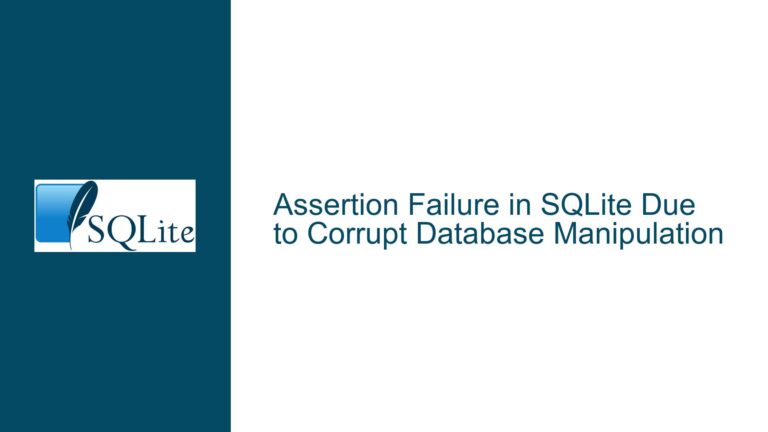SQLite Pragma Function List: Type, Flags, and Argument Interpretation
Interpreting the type, flags, and narg Columns in pragma_function_list
Issue Overview
The core issue revolves around interpreting the columns in the output of the pragma_function_list function in SQLite, specifically the type, flags, and narg columns. The pragma_function_list function provides metadata about the available SQL functions in the current database connection. This metadata includes the function name, whether it is a built-in function, the function type, encoding, number of arguments, and flags that describe additional properties of the function. Understanding these columns is crucial for developers who need to work with SQLite functions programmatically or who are debugging issues related to function usage in SQL queries, triggers, or views.
The type column indicates the kind of SQL function, such as scalar, aggregate, or window function. The flags column is a bitmask that encodes various properties of the function, such as whether it is deterministic, can be used in triggers or views, or has other special characteristics. The narg column specifies the number of arguments the function accepts, with a special value of -1 indicating that the function is variadic and can accept any number of arguments.
Misinterpreting these columns can lead to incorrect usage of SQL functions, such as using a non-deterministic function in a context where determinism is required, or attempting to use a function in a trigger or view when it is not allowed. Therefore, a deep understanding of these columns is essential for effective SQLite development.
Possible Causes
The confusion around the type, flags, and narg columns in pragma_function_list can be attributed to several factors. First, the documentation for pragma_function_list does not provide a detailed explanation of these columns, leaving developers to infer their meanings from the output or from other parts of the SQLite documentation. Second, the flags column is a bitmask, which can be difficult to interpret without a clear understanding of the underlying bit values and their meanings. Third, the narg column uses a special value of -1 to indicate a variadic function, which may not be immediately obvious to developers who are not familiar with this convention.
Additionally, the type column uses single-letter codes (s, w, etc.) to represent different types of functions, which can be ambiguous without a clear reference. For example, the letter s could be interpreted in multiple ways without context, such as "scalar" or "string." Similarly, the flags column contains internal implementation details that are subject to change, making it challenging for developers to rely on specific bit values for long-term compatibility.
These factors contribute to the difficulty in interpreting the pragma_function_list output and underscore the need for a detailed explanation of these columns and their meanings.
Troubleshooting Steps, Solutions & Fixes
To address the issues surrounding the interpretation of the type, flags, and narg columns in pragma_function_list, follow these steps:
Understanding the
typeColumn:
Thetypecolumn inpragma_function_listindicates the kind of SQL function. The possible values are:s: Scalar function. A scalar function returns a single value based on its input arguments. Examples includeabs(),lower(), andupper().w: Window function. A window function performs a calculation across a set of table rows that are somehow related to the current row. Examples includerow_number(),rank(), andsum() OVER.a: Aggregate function. An aggregate function returns a single value calculated from a set of input values. Examples includecount(),sum(), andavg().
To determine the type of a specific function, you can query the
pragma_function_listand filter by the function name:SELECT name, type FROM pragma_function_list WHERE name = 'max';This query will return the type of the
maxfunction, which could be eithers(scalar) orw(window), depending on the context.Decoding the
flagsColumn:
Theflagscolumn is a bitmask that encodes various properties of the function. The bit values are defined in the SQLite header filesqlite3.hand include:SQLITE_DETERMINISTIC (0x000000800): The function is deterministic, meaning it always returns the same result for the same input arguments.SQLITE_DIRECTONLY (0x000080000): The function can only be used in direct SQL statements and cannot be used in triggers or views.SQLITE_SUBTYPE (0x000100000): The function may return a subtype, which is a special type of value that can be used in certain contexts.SQLITE_INNOCUOUS (0x000200000): The function is innocuous, meaning it does not have any side effects and can be safely used in any context.
To interpret the
flagscolumn, you can use bitwise operations to check for specific properties. For example, to find all functions that are not allowed in triggers or views, you can use the following query:SELECT DISTINCT name FROM pragma_function_list WHERE flags & 0x80000;This query will return a list of functions that have the
SQLITE_DIRECTONLYflag set.Interpreting the
nargColumn:
Thenargcolumn specifies the number of arguments the function accepts. A value of-1indicates that the function is variadic and can accept any number of arguments. For example, themaxfunction can be used with any number of arguments, so itsnargvalue is-1.To find all variadic functions, you can use the following query:
SELECT name, narg FROM pragma_function_list WHERE narg = -1;This query will return a list of functions that can accept any number of arguments.
Practical Examples:
To put this knowledge into practice, consider the following examples:Example 1: Finding Deterministic Functions
To find all deterministic functions, you can use the following query:SELECT DISTINCT name FROM pragma_function_list WHERE flags & 0x000000800;This query will return a list of functions that are deterministic and can be safely used in contexts where determinism is required, such as in indexed expressions.
Example 2: Checking Function Usage in Triggers
To check if a specific function can be used in a trigger, you can use the following query:SELECT name, flags & 0x000080000 AS direct_only FROM pragma_function_list WHERE name = 'load_extension';This query will return the
direct_onlyflag for theload_extensionfunction, indicating whether it can be used in triggers or views.Example 3: Identifying Variadic Functions
To identify all variadic functions, you can use the following query:SELECT name, narg FROM pragma_function_list WHERE narg = -1;This query will return a list of functions that can accept any number of arguments, such as
maxandmin.
Best Practices:
- Always check the
type,flags, andnargcolumns when using a function in a new context, such as in a trigger or view. - Use bitwise operations to decode the
flagscolumn and determine the properties of a function. - Be aware that the
flagscolumn contains internal implementation details that may change in future versions of SQLite, so avoid relying on specific bit values for long-term compatibility. - When in doubt, consult the SQLite documentation or use the
pragma_function_listfunction to explore the available functions and their properties.
- Always check the
By following these steps and best practices, you can effectively interpret the type, flags, and narg columns in pragma_function_list and avoid common pitfalls when working with SQLite functions. This knowledge will enable you to write more robust and efficient SQL queries, triggers, and views, and ensure that your database schema is optimized for performance and correctness.






